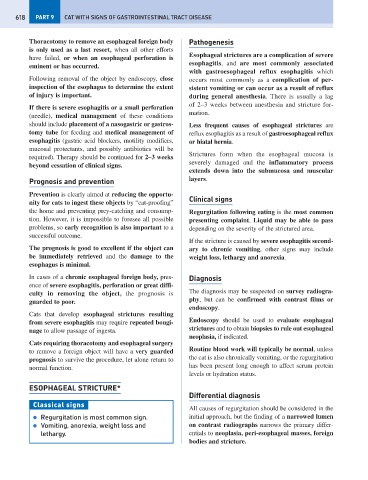Page 626 - Problem-Based Feline Medicine
P. 626
618 PART 9 CAT WITH SIGNS OF GASTROINTESTINAL TRACT DISEASE
Thoracotomy to remove an esophageal foreign body Pathogenesis
is only used as a last resort, when all other efforts
Esophageal strictures are a complication of severe
have failed, or when an esophageal perforation is
esophagitis, and are most commonly associated
eminent or has occurred.
with gastroesophageal reflux esophagitis which
Following removal of the object by endoscopy, close occurs most commonly as a complication of per-
inspection of the esophagus to determine the extent sistent vomiting or can occur as a result of reflux
of injury is important. during general anesthesia. There is usually a lag
of 2–3 weeks between anesthesia and stricture for-
If there is severe esophagitis or a small perforation
mation.
(needle), medical management of these conditions
should include placement of a nasogastric or gastros- Less frequent causes of esophageal strictures are
tomy tube for feeding and medical management of reflux esophagitis as a result of gastroesophageal reflux
esophagitis (gastric acid blockers, motility modifiers, or hiatal hernia.
mucosal protectants, and possibly antibiotics will be
Strictures form when the esophageal mucosa is
required). Therapy should be continued for 2–3 weeks
severely damaged and the inflammatory process
beyond cessation of clinical signs.
extends down into the submucosa and muscular
Prognosis and prevention layers.
Prevention is clearly aimed at reducing the opportu-
Clinical signs
nity for cats to ingest these objects by “cat-proofing”
the home and preventing prey-catching and consump- Regurgitation following eating is the most common
tion. However, it is impossible to foresee all possible presenting complaint. Liquid may be able to pass
problems, so early recognition is also important to a depending on the severity of the strictured area.
successful outcome.
If the stricture is caused by severe esophagitis second-
The prognosis is good to excellent if the object can ary to chronic vomiting, other signs may include
be immediately retrieved and the damage to the weight loss, lethargy and anorexia.
esophagus is minimal.
In cases of a chronic esophageal foreign body, pres- Diagnosis
ence of severe esophagitis, perforation or great diffi-
The diagnosis may be suspected on survey radiogra-
culty in removing the object, the prognosis is
phy, but can be confirmed with contrast films or
guarded to poor.
endoscopy.
Cats that develop esophageal strictures resulting
Endoscopy should be used to evaluate esophageal
from severe esophagitis may require repeated bougi-
strictures and to obtain biopsies to rule out esophageal
nage to allow passage of ingesta.
neoplasia, if indicated.
Cats requiring thoracotomy and esophageal surgery
Routine blood work will typically be normal, unless
to remove a foreign object will have a very guarded
the cat is also chronically vomiting, or the regurgitation
prognosis to survive the procedure, let alone return to
has been present long enough to affect serum protein
normal function.
levels or hydration status.
ESOPHAGEAL STRICTURE*
Differential diagnosis
Classical signs
All causes of regurgitation should be considered in the
● Regurgitation is most common sign. initial approach, but the finding of a narrowed lumen
● Vomiting, anorexia, weight loss and on contrast radiographs narrows the primary differ-
lethargy. entials to neoplasia, peri-esophageal masses, foreign
bodies and stricture.

